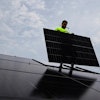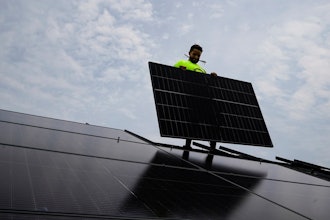On Tuesday, June 25, in a speech before enthusiastic students at Georgetown University, President Obama delivered a message outlining his vision for what the United States ought to do, and what he personally is going to do, about the moral issue of energy production. Now at first glance, you would think that energy production is a technical issue that should be left to engineers and economists. But it was clear from the President’s speech that he thinks it is also a moral issue, as moral as which side you should fight on in a war. His speech, in fact, was peppered with militant terminology. He spoke of having the “courage to act,” he talked of the “fight against climate change,” and expressed his desire for America to “win the race for clean energy.” Toward the end, he called for citizens “who will stand up, and speak up, and compel us to do what this moment demands.” To that end, he announced that he was going to ask the Environmental Protection Agency (EPA) to issue regulations that, according to Obama critic Charles Krauthammer, will “make it impossible to open any new coal plant and will systematically shut down existing plants.”
If the construction of new coal-fired power plants is going to come to an end, maybe we can start building more Ivanpahs instead. Ivanpah is a Piute term meaning “good water,” and is the name of a giant solar-energy project not too far from where Interstate 15 crosses the California-Nevada line on its way to Las Vegas. Built by a consortium of construction and solar-energy firms, plus money from Google investors, Ivanpah consists of three circular arrays of tracking mirrors that direct sunlight onto four-hundred-foot tall “power towers.” Atop each power tower is a cubical black boiler to make steam that turns turbines that drive generators to make electricity. This is the kind of thing that President Obama sees as the future of energy production: it is solar-based, it adds nothing in operation to the nation’s carbon footprint, and it is even respectful of the rights of the 150 or so desert tortoises on the construction site who were carefully inventoried and transported to an equally suitable habitat at a cost of about $50 million—or roughly $300,000 per tortoise.
The engineer in me applauds the Ivanpah project. It is an elegant yet simple solution to several of the problems that plague direct photoelectric energy production using solar cells, one of which is the fact that all days are not equally sunny. When clouds show up, energy production from solar cells drops instantly, and this is not the sort of behavior that power grids like.
The Ivanpah plant mitigates the cloud problem in a couple of ways. First of all, unless there’s a solid cloud cover (not too common in the desert), smaller cloud shadows won’t put the five square miles of mirrors out of commission all at once. And even if insolation, as it’s called, varies over a time period of minutes or even hours, the thermal inertia of the large power-tower boilers means that the plant will still be producing energy even when it is temporarily in the shade due to clouds. So without any extra effort, the Ivanpah project has sidestepped one of the significant technical obstacles faced by solar-cell arrays.
Still, Ivanpah is expensive. According to Wikipedia, the whole project, now nearing completion, will cost about $2 billion when finished. This is roughly four times what a new coal-fired plant of equivalent peak output would cost. And the coal plant will run any time you want it to. True, you have to buy coal over the life of the plant, but this can be factored into the cost, and the economics of that calculation tells you why so much of our electric energy is still supplied by coal.
If we stopped building new fossil-fuel power plants tomorrow and allowed only nuclear, solar, and other renewable forms of new plant construction henceforth, several things would happen. Electricity would become gradually more expensive and possibly less reliable than it would be otherwise. And America’s contribution to the world’s output of carbon in the atmosphere, which has already fallen to 1992 levels, would fall faster and be overwhelmed by the soaring use of coal and other fossil fuels by China, India, and the rest of the world. The overall objective effect on global warming would be minimal.Everyone has a moral compass that helps prioritize ethical decisions. For most people, murder is a more significant moral issue than jaywalking. President Obama views the threat of global warming as a moral equivalent of war, to judge by his Georgetown speech. He clearly wishes to unite the country around a common set of sacrifices that will allow us to hold our heads up before our grandchildren, whose world we should literally save from destruction by the evil forces of climate change.
I will merely point out, as Krauthammer has, that climate change comes in dead last in a poll of 21 matters of concern to Americans. Jobs and the economy are things that the average U. S. citizen is far more concerned about, but the President’s moral compass seems to be insensitive to such concerns. Or perhaps, as a practical politician, he realizes that in his lame-duck term he should spend his limited time on matters where he can act unilaterally, as with his instructions to the EPA, and not waste his energy on proposals he will not be able to get through Congress. Leadership is a mysterious thing, and some leaders who have received the laurels of historical honor were excoriated and criticized at the time. The President obviously feels he is in this category, and often refers to his unpopular proposals as being on the “right side of history.”
But there sometimes is not much difference between being ahead of the pack and simply being out in left field. If there was a truly united sense among Americans that the nation was under an existential threat and climate change was the culprit, President Obama’s rhetoric would fit the national mood and history might go his way. But I fear what we are witnessing is instead the desperate actions of a leader who wants to force his vision of the future on a public that is unwilling to pay the high price for a dubious honor that may not come for generations, if ever.
Sources: I learned about Ivanpah from the print edition of the June 24, 2013 issue of Time Magazine. I used information from the project website http://ivanpahsolar.com, President Obama’s speech of June 25 as transcribed by the Wall Street Journal at http://blogs.wsj.com/washwire/2013/06/25/full-transcript-of-obamas-remar..., Charles Krauthammer’s column for July 6, 2013 as presented in the Pittsburgh Post-Gazette at http://www.post-gazette.com/stories/opinion/perspectives/charles-krautha..., and the Wikipedia articles on “Ivanpah Solar Power Facility” and “Fossil fuel power station.”
This column originally appeared on the Engineering Ethics blog, you can find it by visiting https://engineeringethicsblog.blogspot.com/.























